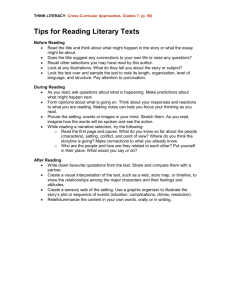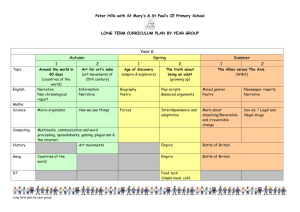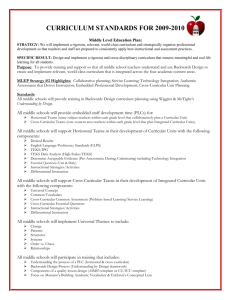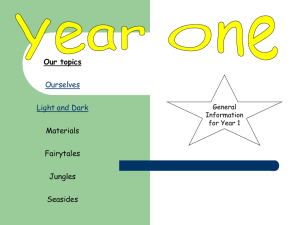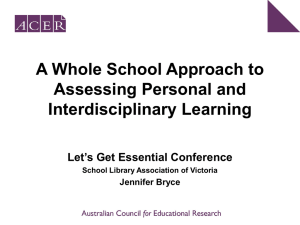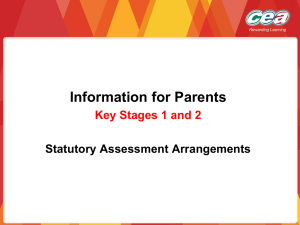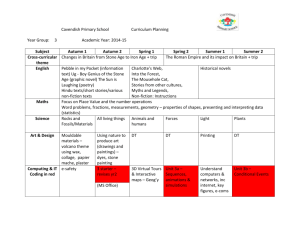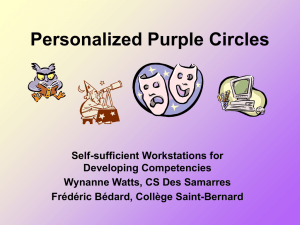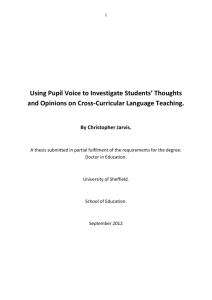Cross Curricula approach to foreign language learning : Projects in
advertisement
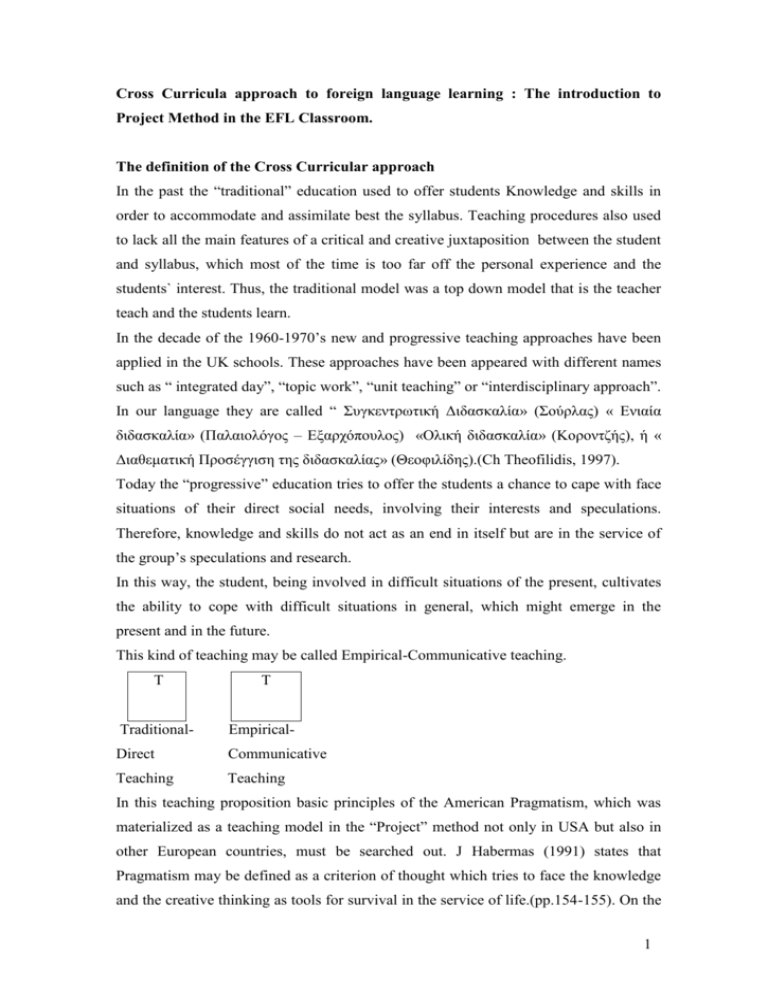
Cross Curricula approach to foreign language learning : The introduction to Project Method in the EFL Classroom. The definition of the Cross Curricular approach In the past the “traditional” education used to offer students Knowledge and skills in order to accommodate and assimilate best the syllabus. Teaching procedures also used to lack all the main features of a critical and creative juxtaposition between the student and syllabus, which most of the time is too far off the personal experience and the students` interest. Thus, the traditional model was a top down model that is the teacher teach and the students learn. In the decade of the 1960-1970’s new and progressive teaching approaches have been applied in the UK schools. These approaches have been appeared with different names such as “ integrated day”, “topic work”, “unit teaching” or “interdisciplinary approach”. In our language they are called “ Συγκεντρωτική Διδασκαλία» (Σούρλας) « Ενιαία διδασκαλία» (Παλαιολόγος – Εξαρχόπουλος) «Ολική διδασκαλία» (Κοροντζής), ή « Διαθεματική Προσέγγιση της διδασκαλίας» (Θεοφιλίδης).(Ch Theofilidis, 1997). Today the “progressive” education tries to offer the students a chance to cape with face situations of their direct social needs, involving their interests and speculations. Therefore, knowledge and skills do not act as an end in itself but are in the service of the group’s speculations and research. In this way, the student, being involved in difficult situations of the present, cultivates the ability to cope with difficult situations in general, which might emerge in the present and in the future. This kind of teaching may be called Empirical-Communicative teaching. T T Traditional- Empirical- Direct Communicative Teaching Teaching In this teaching proposition basic principles of the American Pragmatism, which was materialized as a teaching model in the “Project” method not only in USA but also in other European countries, must be searched out. J Ηabermas (1991) states that Pragmatism may be defined as a criterion of thought which tries to face the knowledge and the creative thinking as tools for survival in the service of life.(pp.154-155). On the 1 other hand, J Dewey supports: “ We learn by doing things” while J Piaget writes “ To understand is to invent”. The lesson of the Empirical- Communicative teaching is characterized by the directness on social matters, creativity, collaboration an inward differentiation, the accession in social life, which must mark every contemporary approach.(K Chrisafidis, 2002). Such an approach is the crosscuricular approach (Διαθεματική). This approach can be defined as the study of a topic or a thematic unit which will be examined not as an isolated school subject like History, Physics, Sociology, but from all possible aspects. For example, subject areas such as Math Art and music, Science, History Social studies may be studied not as an isolated subject but within the context of a given theme. Therefore the subject of transport is examined from the technological, historical, economical, psychological aspect, e.t.c. Interdisciplinary approach ( Διεπιστημονική) is the planning of teaching around a scientific topic, which will be examined within the scope of various school subjects or different sciences. The study of water for example cannot only be restricted to the chemical formula “H20” but it also be means sea, rain, swimming, e.t.c. Therefore water can be studied by other subject areas, such as Physics, Art, poetry, Phylosophy. As far as foreign languages concerned the CCA constitutes a basic prerequisite for the promotion of topics for multicultural and intercultural education. In addition foreign languages can be studied within the scope of various school subjects such as Greek language, Sociology, Anthropology, Geography, Arts, Religion as well as Exact sciences. Such an approach has the following advantages. a) It is more flexible since lessons can be flexibly planned based on students`needs and interests. b) Students examine a topic globally therefore they have the opportunity to acquire knowledge in depth and realize the association and interdependence of various scientific fields. c) In mixtability classes where each student has a different background knowledge base and interests the CCA allows all learners to participate and learn, as it adopts an interdisciplinary focus to teaching and builds upon students`current knowledge base. In other words, all the students, even though they belong to different levels or have 2 different abilities and talents, have the opportunity to use the language through an integrated skills work. d) The above approach allows both teachers and learners to cooperate and to become creative initiative and critical in the teaching and learning procedure. e)The students acquire autonomy and learn through active participatory cooperative activities in and outside the school. Therefore through this unified curriculum the school becomes associated with society and the labour market. f) the school concept is broadened. It promotes projects that cultivate life skills, attitudes and values that can contribute positively to the socialization of students.( J Chrisochoos, 2002) The methodology of the teaching of English based on the cross curricular approach According to the methodology, as it has been referred, the selection of the topic, should be consistent with the students interests and needs. Thus, it is considered very important the themes to be meaningful and substantive as well. In the first step the teacher introduce the idea of a project work. That is the teachers brainstorm some ideas, inform the students about the activity, analyse the language demands, the time required and explain the aims. The key concept should guide the activities and lessons and is expected to provide teachers with a clear focus when they plan the lessons and assign projects. For example, the key focus for the water might be “ We should preserve water because our lives are linked to it”or the key focus for racism might be “We have to believe in gender equality and friendship among all nations because this will enable people to participate effectively in a free society”. In this way, the targets of the subject can be defined and the students are ready to answer the questions for ex. “ What do they have to learn about the water or the racism?” Then through the second step the students agree with the topic and draw up a list of their views. This step is like a warm up and the students are called to brainstorm or speculate and answer some questions based on their previous knowledge. During this procedure teacher can help students writing down words and expressions related to the topic. 3 Also at this phase both teachers and students have to determine about the final outcome, that is, in what way they are going to present the whole work in the final exhibition (Posters, slights, presentations, a school newspaper or a magazine). The third step involves students in project work. Teachers divide the students into groups and undertake the structure of the project. They have to carry out small or largescale research. Teachers can help them to have access to available resources such as libraries or particular bibliographic sources or to Internet and video. R.Roseler divides this step of project in three stages 1) The selection of information 2) the evaluation of information 3) the application of information ( K Chrisafidis 2002 pp. 95-96). In other words in this phase the sts bring in the visuals they have selected and prepare a written text to place under them. This text can have titles descriptions, summaries, which can be handed in. After some corrections the final copy is produced. The fourth step involves students in presentation. A cross-checked presentation follows where each member of the group is called to present his views. Teachers encourage personal interaction and involvement. In other words, he/she encourages them to become aware of their feelings as well as their classmates`feelings. Also he/she expresses his /her own feelings with Ss. Then the students are called to problem solving and decision-making they have to agree or disagree to justify their opinions to give reasons to understand passively the vocabulary and to end up in some conclusions. The final phase is the exhibition where the students have to present their final product. It may take place in the school or in a convention. It may last from ten days to two weeks. In the exhibition, at intervals the sts stand by their work (posters) and answer to questions or provide information. The last step is the phase of evaluation. The group is called to estimate the value of the results of their work that is to examine if the targets have achieved. A questionnaire is given out to be answered which is intended to reinforce the sts `knowledge rather than to test it. The highest scoring group receives a reward. As already mentioned, in cross-curricular instruction emphasis is placed on the holistic approach to teaching and learning rather than on a fragmented treatment of subjects in isolation. To this aim CCA promotes the planning of teaching around a common thematic unit, which will be examined from several perspectives and within the scope of various school subjects. Here we should point out that the descriptions of foreign 4 civilizations included in course books are a fine issue. Prejudice and stereotypes interfere in people’s nations. Therefore in the cases where different cultures are involved there is a risk the students to interpret whatever is said to them according to their own behavioral rules, thus ending up misinterpreting the real meaning of the interlocutor’s words. Teachers must be aware of the human rights education in order to infuse the students a different way of thinking that is to teach learners not what to think but how to think critically. The Project method in the three levels. elementary school-high school-lyceum The project work method can be applied to any educational stage starting from a preschool till the higher education. Also this method can be applied either to a small unit or to a more general subject. Therefore it can last from a week to a whole year time. . In the following paragraphs we are going to give some indicative examples, which can be based on the cross-curricular approach-project method, starting from the primary education. From the third grade of the primary education the empirical-communicative teaching can follow a progressive process, which will start from every day life situations and continue with the searching of scientific subjects. The students learn to work with the project method progressively and they integrate this work when they go to high school. However, there are some difficulties in the application of this method because of the obligatory national curriculum in the elementary school as well as in the high school and lyceum. P. Struck (1980,p.86) suggests the establishment of some obligatory weeks in the national curriculum in which the teachers and the students can apply the project method in teaching. Example 1 The students of the sixth grade of the elementary school decide to make a flower –bed in their schoolyard and to cultivate plants and flowers. First they choose the suitable place then they make the design and divide the different parts of the space and finally they choose the kinds of plants and flowers. In this project the subjects areas, which are studied, are the following: Geometry, Botanic, Chemistry, Ecology, Handicraft etc. When the flowerbed is completed the first 5 phase of the project is integrated while other new perspectives may be raised. Other subjects areas suitable for this grade for example can be the population statistics in our village, the problem of flood in my city and the searching of the causes etc. Example 2 For the students of high school a subject area, which could be studied with the project work method, is the British culture. The subjects, which can be involved, are History, Geography, Literature, Sociology, Art, Language and Customs. The students have a great choice in topics such as the histoty of London, Madam Tussaud Museum, Scotland as a different world, Shakespear`plays, Wales, British schools, English food. . Therefore, the above topic is very interesting motivating and substantive as well. Example 3 An example of the cross-curricular approach in practice could be a project on Epidavros or Ancient Olympia. It is difficult to see how this could involve any of the teachers of religion, History, ancient Greek, modern Greek, geography, civic education, technology, and of course foreign languages. Each teacher will contribute to the project, with activities involving the pupils in learning about Epidavros or Olympia and relating this to modern world. The foreign language teacher could engage learners in activities relevant to their age and level of language, such as searching the web for reference to Epidavros writing a guide book for foreign visitors, taking a foreign visitor around the site, writing to a friend describing a school outing there, taking photographs and labeling them for an international photo exhibition. Example 4 The following example can be done using the Internet. The foreign language teacher could engage students in activities such as searching the web for reference to articles, letters jokes and stories even proverbs from all readers whenever they are. If they are willing to write about anything they like and send be e-mail. The students after a period of time gather what they have found on their e- mail and write an assignments of all these in categories for examples Jokes from England, France Italy or Letters from USA From China etc. Lyceum too. This method in this level can help students to form their personalities and to prepare them to participate in society as future citizens. 6 Subjects areas, such as Aids, unemployment, drugs, ecology, cultural inheritance, multiculturalism, racism etc can be examined holistically involving Literature, Economy, Physics, Chemistry, Maths, Sociology, Ethics and languages. An example of the students of the 13th grade of the Vocational school in Schwetzingen of West Germany. The topic was “ Perses” by Aeschylus The performance was a modern approach of the ancient tragedy and about seventy students took part in it. The presence of the teachers was distinctive and consultative. The subjects areas involved were language, architecture, technology, history, aesthetics, Arts. The performance was extraordinary since every team had an important contribution to the integration of it. What the students have benefited from this ancient tragedy is of course obvious.(K Chrisafidis, 2002). Conclusion The cross-curricular approach offers many benefits not the least, of which are involving teachers in a new, exciting and challenging way of teaching. Teachers as well as students will broaden their vision with this more global approach to education. However. It will not be easy for all teachers to adopt this approach. Some have serious concerns, which must be faced if this approach is to be implemented effectively. For example for foreign language teacher there may be a feeling of insecurity as the language emphasis shifts away from the well-known content of course books into new, unexplored realms. Also the language teacher must have a good knowledge of other subjects. This is not such a worry at primary level teaching, but is definitely a problem at secondary level. There is also the danger that the foreign language teacher will spend more time developing scientific concepts, for which he is not trained, than language concepts. Then there is the question how useful this scientific language is going to be for the child. Is he going to talk about scientific experiments in English? With the cross-curricular approach, each teacher covers the aspect of the topic that relates to his speculation, so avoiding these problems. All the above thoughts suggest that we should proceed slowly. And with caution, providing training, a time allowance and support in the way of materials and project 7 packs. The cross-curricular approach has much to offer and deserves to be taken seriously. References Berwick Dorothy “ Does the cross-curricular approach lead to contentment?” in Bridges vol.9, Spring-Summer 2002. Bonnett, M “ Child-centredness and the problem of structure in project work” British Journal of Education, 16 (1),3-6. Chrisafidis, K Empirical-Communicative Teaching- The access of the Project-method in School, Gutenberg, Athens 2002. Chrysochoos Joeseph E. et al “ The Methodology of the teaching of English as a Foreign Language with Reference to the Crosscurricular Approach and Task-based Learning”, The Pedagogical Institute, Athens 2002. Dewey, J. How we think. Boston: Heath 1910. Habermas, J Erkenntnis and Interesse, Suhrkamp, Frankfurt a.M 1991. Mattheoudaki Marina “ Human Rights and TEFL: Globalizing School Education” in Bridges vol.5, January 2001. Piaget,J To understand is to invent. New York: Grossman 1973 Roseler, R Die Planung des Nichtplanbaren (b: etabu), Beltz Weinheim, 1978 in Chrisafidis K, pp. 95-96. Struck, P Projektunterricht,Kohlhammer, Stuttgard, 1980. Theofilidis, Ch The Cross-curricular Approach to Teaching- Grigoris, Ed., Athens 1997 Waters, D Primary school projects, Heinneman, London 1982 Water, D & Brandham, M , A book of projects, Mills&Boon, London 1972 8
